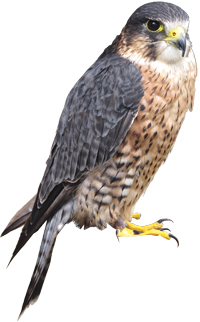Cornell project brings peregrines back to the eastern United States
Read the full article (PDF) | Vote on future topic | Search archives
September 8, 1973 | Vol. 104 | No. 10
Cornell project brings peregrines back to the eastern United States
No bird was more harmed by the overuse of DDT than America’s peregrine falcon. One of the most voracious and skilled raptors, the long-winged, gray and white peregrine received concentrated doses of pesticides from its prey, and the eggshells of its chicks began thinning dangerously during the 1940’s. Finally, the species vanished entirely from the eastern United States.
Now a team of ornithologist at Cornell University is trying to reestablish the eastern peregrine population, while uncovering secrets of the shy predator’s behavior, physiology and breeding habits. Cornell’s famous hawk barn, which can accommodate 90 large birds, is being converted into an artificial breeding ground for the falcons, earning the local nickname Peregrine Palace. The National Science Foundation and the private Peregrine Fund support the work. Cornell professor Thomas J. Cade is project director.
Until very recently, breeding falcons in captivity was considered so difficult that few falconers would have believed regeneration of a lost population, or even supplying enough birds for sport, could be accomplished breeding. But 20 you peregrines were hatched and reared at Cornell this year from three fertile pairs, and more are coming.
UPDATE | October 22, 2011
Peregrines made comeback, doing just fine today
 Recent estimates suggest the number of breeding pairs of peregrine falcons in the United States and Canada now exceeds 4,000.
Recent estimates suggest the number of breeding pairs of peregrine falcons in the United States and Canada now exceeds 4,000.
By 1975, Cornell researchers had bred enough peregrine falcons in captivity to begin releasing them into the wild, where they could rebuild populations eradicated by DDT. Peregrine Fund researchers, field assistants and volunteers made the young birds new homes on cliffs and platforms built high above the ground. These human helpers monitored the falcons’ progress and provided fresh meat until they could make it on their own.
The early days weren’t easy, especially for caretakers who watched their baby birds being picked off by great horned owls or golden eagles. But supplementing wild nesting sites with releases in urban environments, where natural predators were scarce, proved promising.
Over the next two decades, the Peregrine Fund and other organizations released more than 6,000 peregrines throughout the United States and Canada. 1980 marked a turning point for the falcons, with the first natural reproduction east of the Mississippi River in more than 20 years. By the late 1990s, when major release efforts had waned, the number of nesting pairs in the whole of the United States and Canada had increased from 159 to 1,650. And in 1999, peregrines were taken off of the endangered species list in the United States.
The peregrine falcon’s recovery will probably go down in history as one of conservation’s greatest success stories. Government officials, scientists and citizens came together to ensure that these birds’ masked faces and high-dive displays would be around for future generations to appreciate. Today, there are more than 4,000 breeding pairs of peregrine falcons living throughout the United States and Canada.
The Peregrine Fund closed its Cornell facility and is now headquartered in Boise, Idaho, where it continues to monitor potential threats to peregrines, such as last year’s Gulf oil spill. Conservationists with the group have also turned their attention to other endangered birds, including aplomado falcons and California condors. —Elizabeth Quill
Credit: Powershot36/Dreamstime